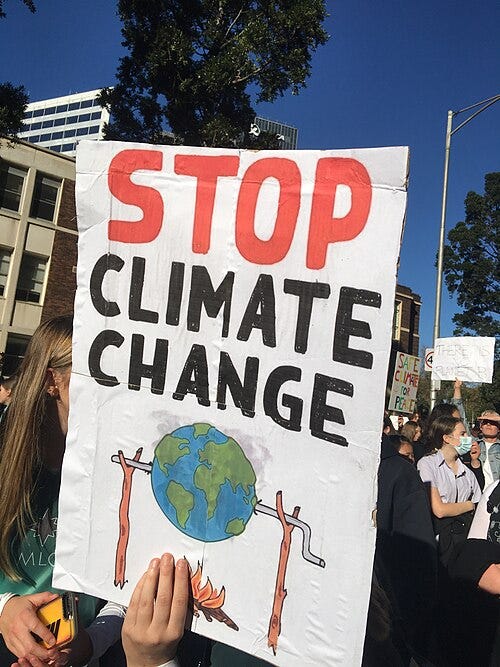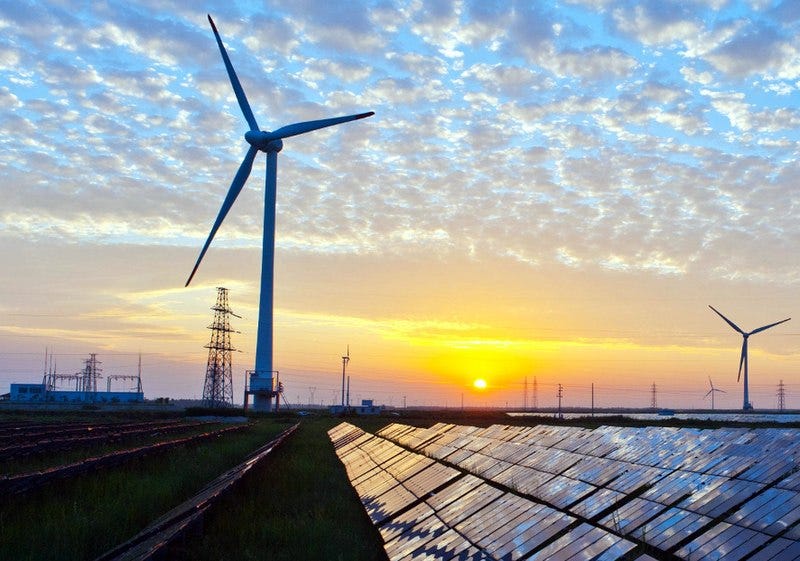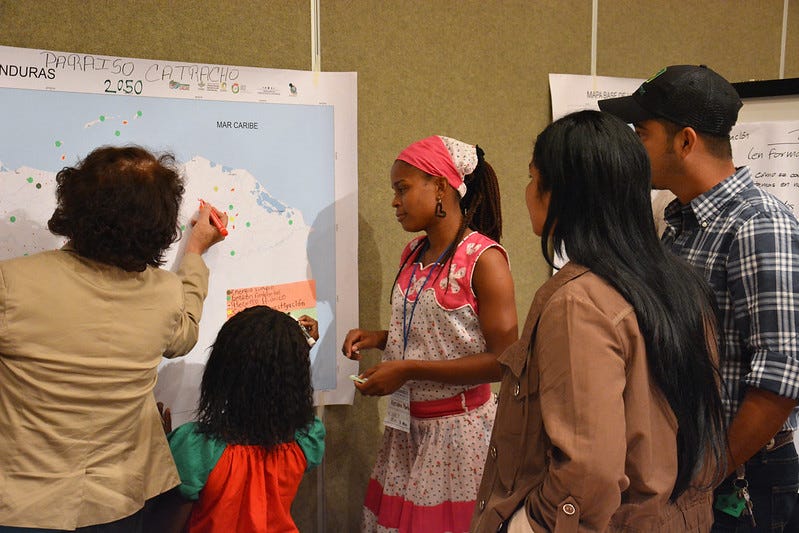Global Shield Briefing (7 May 2025)
The stories, the economics and the governance of climate change - and what it says about global catastrophic risk.
The latest policy, research and news on global catastrophic risk (GCR).
Global Shield is, as you might be sick of us repeating, focused on “all-hazards” policy. We want governments to take actions that hit multiple risk vectors at the same time. Policies that build awareness, understanding, preparedness, resilience and response to the full spectrum of global catastrophic risk is a powerful approach. Especially because efforts in one domain are often transferable to others. Lessons from dealing with specific threats can apply to all hazards.
Climate change presents a particularly ripe area for learning. Hard-earned successes, uphill challenges and standout insights from the climate change arena are relevant for many other threats. This latest briefing pulls only from climate change news and research; it’s been a busy few weeks in that regard. But with an all-hazards lens, we can scope out what it says about global catastrophic risk as a whole – like zooming out into a panoramic view of the landscape.
Influencing through stories, not statistics

Around 5,000 Australians were asked what would change their mind on climate change. Four typical responses emerged: evidence and information, trusted sources, action being undertaken, and nothing. The most common response was a desire for better evidence and information. Participants said they wanted clear explanations rather than jargon, and science that didn’t feel politicised or agenda-driven. But sceptics were the most resistant to updating their beliefs in response to scientific evidence. Many respondents said their views could shift if they saw meaningful action, particularly from governments and large corporations.
Despite worsening climate change and global carbon dioxide emissions still growing, progress is being made to reduce the increasing risk. The worst-case scenario outlined by UN climate scientists – around 4-5°Celsius of warming – is looking less likely. Clean energy solutions, such as wind and solar energy, battery technology and carbon removal, are increasing in effectiveness and uptake.
Policy comment: Story-telling and narratives are likely to be more effective tools for communicating about global catastrophic risk and for driving policy action. Policymakers or citizens that are skeptical are more likely to be persuaded by personal stories of the harms posed by crises and global events. Evidence and information – although needed to initially justify policy change – might prove ineffective in changing positions. Stories around the solutions also provide hope and optimism, while allowing policymakers and people to recognize the broader societal and economic benefits. A collection of narratives for how global catastrophic risk harms individuals and communities, and potential case studies on successful action could be powerful advocacy tools.
Understanding the full economic impacts of GCR

The previous estimates of the economic damage from climate change is likely to have been massively underestimated, according to new research. Most prior research estimated that extreme warming of 4°Celsius would negatively impact the global economy by an average of around 11 percent by 2100. New modelling – which takes into consideration second order effects, such as on human health, disease transmission, migration and labor productivity – brings this estimate to 40 per cent.
Major banks, such as Morgan Stanley and JPMorgan, are acknowledging that the goal of keeping warming below 2°Celsius above preindustrial level is likely to fail, according to Scientific American. Morgan Stanley analysts are expecting a 3° increase, due in part to “recent setbacks to global decarbonization efforts”.
Just under 5 percent of Australian homes and businesses are already at high risk today due to climate-induced hazards, according to analysis conducted by Climate Valuation and The Climate Council. Another 10 percent at moderate risk. By 2100, the number of high-risk properties are expected to increase to almost 9 percent.
Policy comment: Banks, government and citizens are likely to be underestimating the economic cost of climate change, and global catastrophic risk more broadly. The assessment of economic impacts, while useful, struggle to factor in cascading impacts, tail risk and potential tipping points. For example, catastrophic crises could make parts of the world uninhabitable, leading to mass migration. Or climate change and other threats could increase the risk of deadly diseases, which have their own economic and societal impacts. Governments should be continuously studying and assessing the holistic economic impacts of GCR. These impacts could include job losses, GDP contraction, market volatility, and the second and third-order impacts on the healthcare, energy and agriculture sectors. A dedicated team within the Treasury could be established to conduct this work. Such a team could also then perform cost-benefit analyses to assess the viability of various risk reduction efforts and make recommendations to policymakers.
Empowering action from above

US states are taking increasing action on climate change. Collaboration between states is also on the rise, with the US Climate Alliance, a bipartisan coalition of 24 governors, aiming to accelerate climate action, reduce emissions and track progress towards global targets. America is All In is another coalition, this time between thousands of policy, civil society and business leaders. Coalition members continue to make progress, including at state and city level. Over 130 mayors and local leaders representing around 25 million people sent a letter to Congress calling on them to preserve the 13 federally-funded clean energy tax credits.
Around half of corporate executives would move operations and shift supply chains within five years to better access renewables-based power systems, according to a survey of roughly 1,500 business leaders of medium and large companies across 15 countries. Over a ten-year time frame, that figure jumped to almost 90 percent. Almost all American executives said that they wanted the US government to expand renewable electricity in the grid.
A recent research article looks at the inadequacy of adaptation to climate change, and pushes for cities and urban areas to be more transformative in their climate resilience. The author proposes solutions such as holistic risk assessments, addressing economic and social conditions of disasters, and whole-of-society responses.
Policy comment: Global catastrophic risk reduction cannot be left only to the federal government. All levels of government, and all actors across society, particularly business, have important roles to play. In some federated systems, like the US, Brazil and Australia, states and territories are central to emergency response and recovery. However, countries where the federal government does not lead will struggle the most on global catastrophic risk. Beyond shaping the policy and regulatory environment, federal governments can help fund state, local and community efforts at preparedness and resilience. Governments can foster a marketplace for technologies and capabilities that might be crucial to risk reduction efforts, like renewable energy, alternative foods and resilient infrastructure. Actors across society look to the federal government to pave the way for long-term efforts. Of course, national leaders can make agreements between each other and shape each others’ perspectives and actions. And heads of government have the bully pulpit; they can shift domestic mindsets. Advocates for global catastrophic risk reduction should consider each of these pathways for the federal level to empower other levels of governance.
Last chance to apply for new opportunity with Global Shield
Applications close on 18 May for a new role: the Global Growth and Development Manager. This role will lead our organization’s growth into new countries. As an organization that seeks to reduce global catastrophic risk, we believe that all countries can make a difference. And we believe that Global Shield can make a difference in those countries. The role is to identify promising countries for expansion, build relationships with partners in those countries, and establish a presence that can effectively execute on our mission. Please share with your networks, or consider applying yourself.
This briefing is a product of Global Shield, an international advocacy organization dedicated to reducing global catastrophic risk of all hazards. With each briefing, we aim to build the most knowledgeable audience in the world when it comes to reducing global catastrophic risk. We want to show that action is not only needed, it’s possible. Help us build this community of motivated individuals, researchers, advocates and policymakers by sharing this briefing with your networks.

